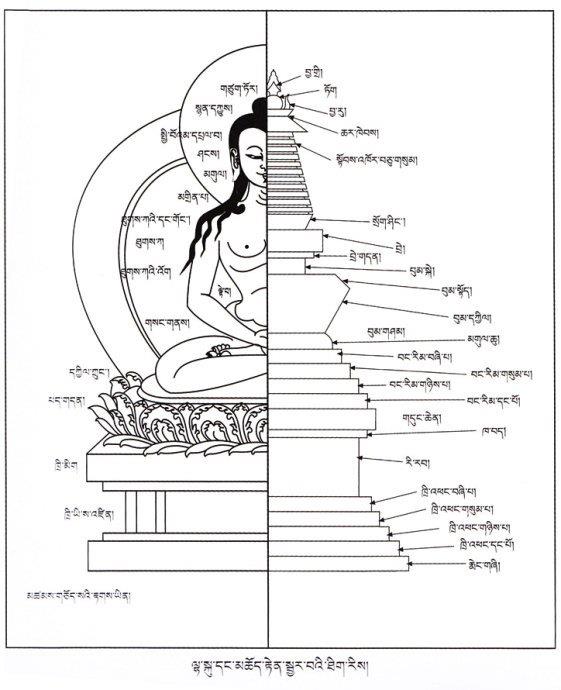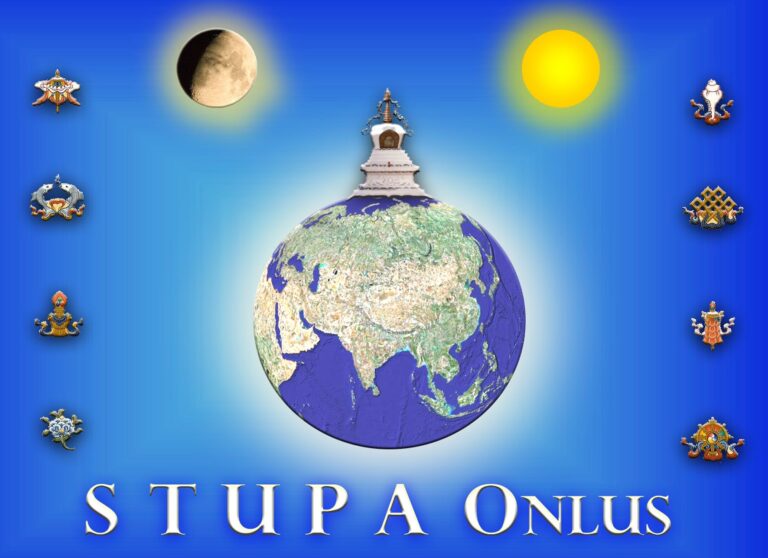According to the Gelugpa tradition
1. The platform at the basis of the stupa symbolizes the ten virtues:
Three of body:
· To protect life,
· To practice generosity,
· To have a correct conduct;
Four of speech:
· To tell the truth,
· To reconcile,
· To speak in a calm and gentle way,
· To make sensible discourses;
Three of mind:
· To have no attachments,
· To be altruistic,
· To believe in correct views.
2. The three steps above the platform symbolize the three objects of refuge, to which one commits:
· The Guru and the Buddha,
· The teachings (the Dharma),
· The community of practitioners (the Sangha).
3. The lion throne symbolizes the supremacy of a Buddha over the entire universe.
4. The vase of treasures symbolizes the eight noble riches.
5. The small and the large lotus symbolize the six perfections:
· generosity,
· morality,
· patience,
· joyous effort,
· concentration,
· wisdom.
6. The four angles at the basis of the throne symbolize the four immeasurables:
· immeasurable love,
· immeasurable compassion,
· immeasurable joy,
· immeasurable equanimity.
7. The first step symbolizes the four close placements of mindfulness:
· the body,
· feelings,
· the mind,
· phenomena.
8. The second step symbolizes the four thorough abandonings:
· The thorough abandoning which is the non-generation of non-virtues not yet generated,
· The thorough abandoning which is the abandoning of the non-virtues already generated,
· The thorough abandoning which is the generation of virtues not yet generated,
· The thorough abandoning which is the increasing of virtues already generated.
9. The third step symbolizes the four legs of magical manifestation:
· aspiration,
· effort,
· intention,
· analysis.
10. The fourth step symbolizes the five powers:
· faith,
· effort,
· mindfulness,
· meditative stabilization,
· wisdom.
11. The immovable base of the vase symbolizes the five forces.
12. The different aspects of the vase symbolize the seven branches of Enlightenment:
· correct mindfulness
· correct discrimination of phenomena,
· correct effort
· correct joy,
· correct pliancy,
· correct meditative stabilization,
· correct equanimity.
13. The base of the summit symbolizes the noble eightfold path:
· correct view,
· correct understanding,
· correct word,
· correct aims of action,
· correct livelihood,
· correct effort,
· correct mindfulness,
· correct meditative stabilization.
14. The tree of life symbolizes the ten types of knowledge:
· of phenomena,
· of mind,
· of the law of cause and effect,
· of illusions,
· of suffering,
· of the cessation of suffering,
· of the path that leads to cessation,
· of destruction,
· of non-appearance,
· the ten types of transcendental knowledge.
15. The thirteen rings symbolize the ten mystic powers and the three essential types of mindfulness. They also symbolize the thirteen Bhumi.
16. The umbrella and its support symbolize the victorious state of Enlightenment.
17. The two-part zaraisak symbolizes the ornaments of all the supreme qualities.
18. The moon symbolizes the elimination of all sufferings.
19. The sun symbolizes the radiance of the thousand lights of compassion.
20. The nada (the jewel) symbolizes the realization of all the aspirations.


